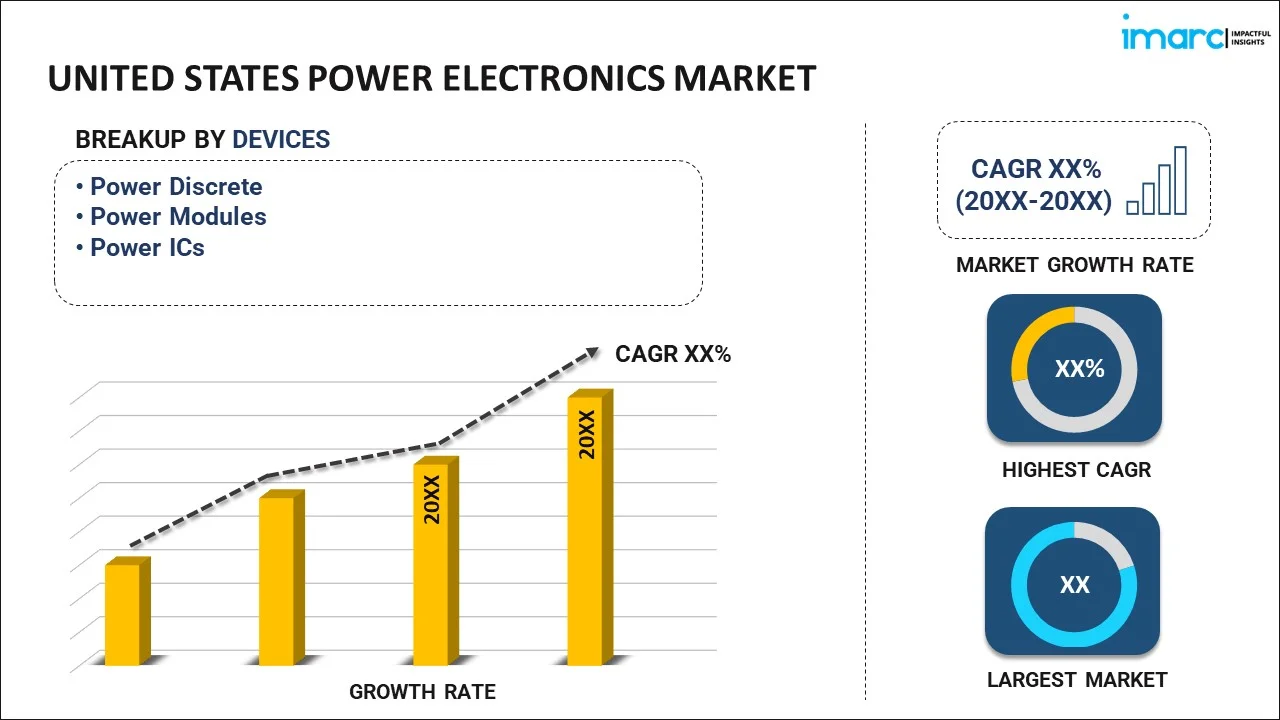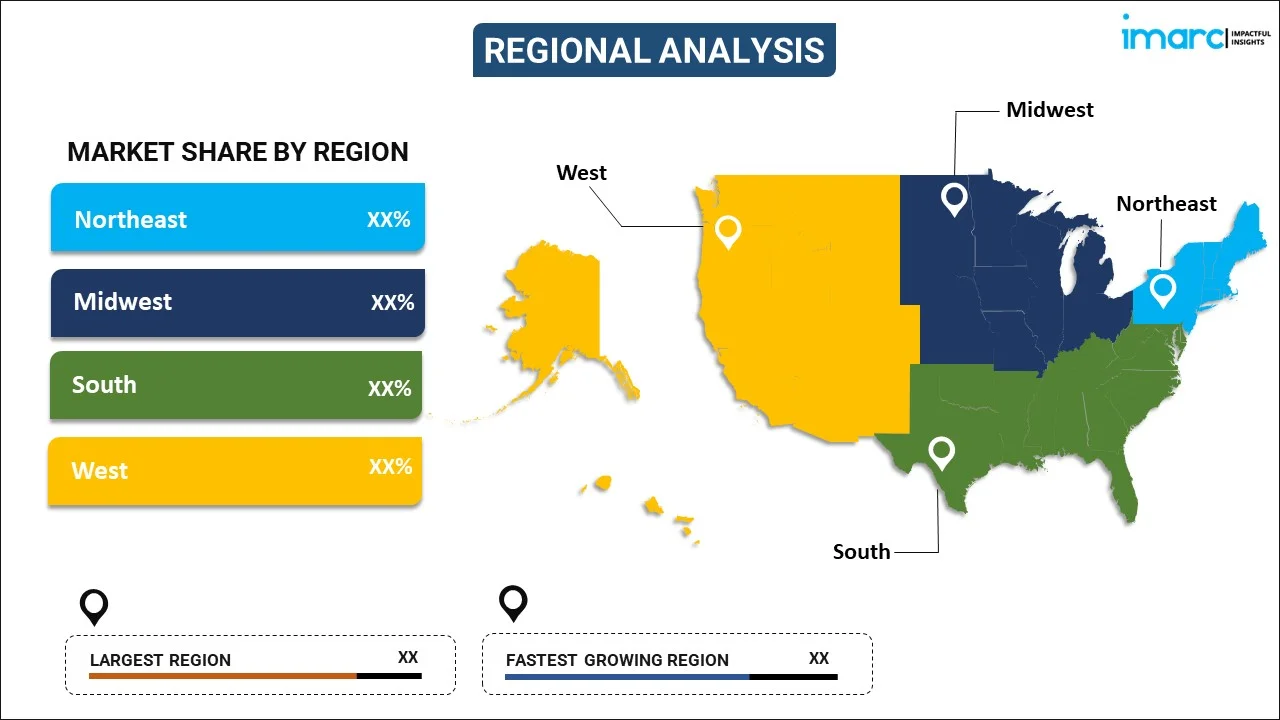
United States Power Electronics Market Report by Device (Power Discrete, Power Modules, Power ICs), Material (Silicon, Sapphire, Silicon Carbide, Gallium Nitride, and Others), Application (Power Management, UPS, Renewable, and Others), Voltage (Low Voltage, Medium Voltage, High Voltage), End Use Industry (Automotive, Military and Aerospace, Energy and Power, IT and Telecommunication, Consumer Electronics, and Others), and Region 2025-2033
Market Overview:
United States power electronics market size reached USD 8,134.9 Million in 2024. Looking forward, IMARC Group expects the market to reach USD 14,644.1 Million by 2033, exhibiting a growth rate (CAGR) of 6.75% during 2025-2033. The growing emphasis on energy efficiency, increasing concerns among the masses about environmental sustainability and energy conservation, and the escalating demand for data storage and processing represent some of the key factors driving the United States power electronics market share.
|
Report Attribute
|
Key Statistics
|
|---|---|
|
Base Year
|
2024 |
|
Forecast Years
|
2025-2033
|
|
Historical Years
|
2019-2024
|
| Market Size in 2024 | USD 8,134.9 Million |
| Market Forecast in 2033 | USD 14,644.1 Million |
| Market Growth Rate (2025-2033) | 6.75% |
United States Power Electronics Market Analysis:
- Growth Drivers: Growing demand for electric vehicles (EVs) renewable energy technologies, and industrial automation is propelling adoption. Development in semiconductor materials and government incentives for energy-efficient technologies also drive robust United States power electronics market growth.
- Key Market Trends: Rising adoption of wide-bandgap semiconductors, convergence with smart grid technologies, and IoT-based power solutions adoption are the primary trends. Compact, efficient, and high-performance power management systems are the priorities for industries.
- Market Opportunities: Electric mobility infrastructure, smart home energy management systems, and industrial automation are the areas with opportunities. Charging network expansion, renewable integration, and digital power control systems offer potential for high growth and innovation.
- Market Challenges: Challenges are high upfront costs, intricate thermal management, and supply chain interruption. Technology advancement at a high pace and requirement of a specialist skill set also pose barriers to entry and limit massive market penetration in the United States power electronics market analysis.
Power electronics is a branch of electrical engineering that deals with the conversion, control, and manipulation of electrical power. It involves the use of electronic devices to efficiently convert and regulate electrical energy from one form to another, making it suitable for various applications. It enhances energy efficiency by minimizing losses during energy conversion, leading to reduced energy consumption. It can improve the quality of electrical power by stabilizing voltage and frequency, reducing the risk of disruptions. It enables variable speed control in electric motors, leading to energy savings and improved performance in applications like electric vehicles and industrial machinery. It aids in integrating renewable energy sources like solar and wind into the grid, ensuring a stable power supply. It contributes to a reduced carbon footprint and environmental impact. It facilitates the conversion of direct current (DC) power generated by solar panels and wind turbines into alternating current (AC) power for grid connection. It is widely used in electric vehicle propulsion, industrial machines, and home appliances to control the speed and torque of electric motors. It is also utilized in heating, ventilation, and air conditioning (HVAC) systems for precise control of temperature and energy efficiency.
United States Power Electronics Market Trends:
Electrification of Transportation (EVs and Charging Infrastructure)
The drive for electric mobility is the top driver in the U.S. power electronics market. With policies from the government encouraging emission reductions, electric vehicle (EV) penetration is gaining speed. Power electronics are instrumental in EV applications, facilitating efficient charging of batteries, motor control, and power conversion. Primary devices such as onboard chargers, DC-DC converters, and inverters are essential to EV reliability and performance. Further, the growing need for more widespread charging infrastructure in both public and private domains is creating larger demand for high-voltage capable and fast-charging power electronics. Suppliers and automakers are making significant investments in future generations of power semiconductor technology such as silicon carbide (SiC) and gallium nitride (GaN)—in order to enhance efficiency and thermal performance. The wave of electrification is transforming requirements in power electronics and driving continued market growth throughout the automotive supply chain.
Integration of Renewable Energy Sources
The increasing use of solar, wind, and other alternative energy sources is contributing substantially to the United States power electronics market demand. Such energy systems need efficient conversion and control solutions to drive variable outputs into the electrical grid. Power electronics like inverters, rectifiers, and controllers are essential for converting DC output from solar panels or wind turbines into AC power that is compatible with the grid. As grid managers pursue more contentment, power electronics provide for intelligent routing, storage, and balancing of contentment. As decentralized generation such as rooftop photovoltaics and community wind installations become prevalent, the demand for high-efficiency, localized power management systems grows. As decarbonization and energy self-sufficiency become focal points at the federal and state levels, incentives are encouraging renewable ventures, thereby opening doors to power electronics suppliers. These networks also have to satisfy changing grid standards and cybersecurity expectations, adding complexity and value.
Advancements in Wide-Bandgap Semiconductor Technologies
Technological innovation in wide-bandgap (WBG) semiconductors—silicon carbide (SiC) and gallium nitride (GaN) specifically—is transforming the U.S. power electronics sector. They possess higher efficiency, higher operating temperatures, reduced device size, and greater switching speed over conventional silicon. They are being used across industries like electric vehicles, renewable energy, aerospace, and industrial automation. For instance, EVs can be driven longer and charged more quickly with SiC inverters, and GaN devices provide space-saving and efficient power supply for data centers and consumer electronics. WBG devices have higher efficiency, which also means less heat generated, reducing cooling needs and operational expenses. With falling manufacturing costs for SiC and GaN devices, the adoption is widening. Government support and partnership with industry are driving research and commercialization, putting WBG semiconductors at the foundation of future power electronic innovation in America.
United States Power Electronics Market Segmentation:
IMARC Group provides an analysis of the key trends in each segment of the market, along with forecasts at the country level for 2025-2033. Our report has categorized the market based on device, material, application, voltage, and end use industry.
Device Insights:

To get more information on this market, Request Sample
- Power Discrete
- Diode
- Transistors
- Thyristor
- Power Modules
- Intelligent Power Module
- Power Integrated Module
- Power ICs
- Power Management Integrated Circuit
- Application-Specific Integrated Circuit
The report has provided a detailed breakup and analysis of the market based on the device. This includes power discrete (diode, transistors, and thyristor), power modules (intelligent power module and power integrated module), and power ICs (power management integrated circuit and application-specific integrated circuit).
Material Insights:
- Silicon
- Sapphire
- Silicon Carbide
- Gallium Nitride
- Others
A detailed breakup and analysis of the market based on the material have also been provided in the report. This includes silicon, sapphire, silicon carbide, gallium nitride, and others.
Application Insights:
- Power Management
- UPS
- Renewable
- Others
The report has provided a detailed breakup and analysis of the market based on the application. This includes power management, UPS, renewable, and others.
Voltage Insights:
- Low Voltage
- Medium Voltage
- High Voltage
A detailed breakup and analysis of the market based on the voltage have also been provided in the report. This includes low voltage, medium voltage, and high voltage.
End Use Industry Insights:
- Automotive
- Military and Aerospace
- Energy and Power
- IT and Telecommunication
- Consumer Electronics
- Others
The report has provided a detailed breakup and analysis of the market based on the end use industry. This includes automotive, military and aerospace, energy and power, IT and telecommunication, consumer electronics, and others.
Regional Insights:

- Northeast
- Midwest
- South
- West
The report has also provided a comprehensive analysis of all the major regional markets, which include Northeast, Midwest, South, and West.
Competitive Landscape:
The market research report has also provided a comprehensive analysis of the competitive landscape. Competitive analysis such as market structure, key player positioning, top winning strategies, competitive dashboard, and company evaluation quadrant has been covered in the report. Also, detailed profiles of all major companies have been provided.
Latest News and Developments:
- In December 2024, ABB will acquire the power electronics unit of Gamesa Electric from Siemens Gamesa, expanding its renewable power conversion portfolio. The deal enhances ABB’s capabilities in wind converters, solar inverters, and battery storage, adding 40 GW of serviceable capacity. With 400 new employees and two factories in Spain, the move supports ABB’s growth strategy in renewables and deepens its engineering and service expertise globally.
United States Power Electronics Market Report Coverage:
| Report Features | Details |
|---|---|
| Base Year of the Analysis | 2024 |
| Historical Period | 2019-2024 |
| Forecast Period | 2025-2033 |
| Units | Million USD |
| Scope of the Report | Exploration of Historical and Forecast Trends, Industry Catalysts and Challenges, Segment-Wise Historical and Predictive Market Assessment:
|
| Devices Covered |
|
| Materials Covered | Silicon, Sapphire, Silicon Carbide, Gallium Nitride, Others |
| Applications Covered | Power Management, UPS, Renewable, Others |
| Voltages Covered | Low Voltage, Medium Voltage, High Voltage |
| End Use Industries Covered | Automotive, Military and Aerospace, Energy and Power, IT and Telecommunication, Consumer Electronics, Others |
| Regions Covered | Northeast, Midwest, South, West |
| Customization Scope | 10% Free Customization |
| Post-Sale Analyst Support | 10-12 Weeks |
| Delivery Format | PDF and Excel through Email (We can also provide the editable version of the report in PPT/Word format on special request) |
Key Benefits for Stakeholders:
- IMARC’s industry report offers a comprehensive quantitative analysis of various market segments, historical and current market trends, market forecasts, and dynamics of the United States power electronics market from 2019-2033.
- The research report provides the latest information on the market drivers, challenges, and opportunities in the United States power electronics market.
- Porter's five forces analysis assist stakeholders in assessing the impact of new entrants, competitive rivalry, supplier power, buyer power, and the threat of substitution. It helps stakeholders to analyze the level of competition within the United States power electronics industry and its attractiveness.
- Competitive landscape allows stakeholders to understand their competitive environment and provides an insight into the current positions of key players in the market.
Key Questions Answered in This Report
The power electronics market in the United States was valued at USD 8,134.9 Million in 2024.
The United States power electronics market is projected to exhibit a CAGR of 6.75% during 2025-2033, reaching a value of USD 14,644.1 Million by 2033.
Key factors driving the U.S. power electronics market include rising adoption of electric vehicles, expanding renewable energy integration, industrial automation, and demand for energy-efficient systems. Technological advances in wide-bandgap semiconductors and supportive government policies also fuel growth, alongside increasing need for smart grid infrastructure and modernized power management solutions.
Need more help?
- Speak to our experienced analysts for insights on the current market scenarios.
- Include additional segments and countries to customize the report as per your requirement.
- Gain an unparalleled competitive advantage in your domain by understanding how to utilize the report and positively impacting your operations and revenue.
- For further assistance, please connect with our analysts.
 Request Customization
Request Customization
 Speak to an Analyst
Speak to an Analyst
 Request Brochure
Request Brochure
 Inquire Before Buying
Inquire Before Buying




.webp)




.webp)












